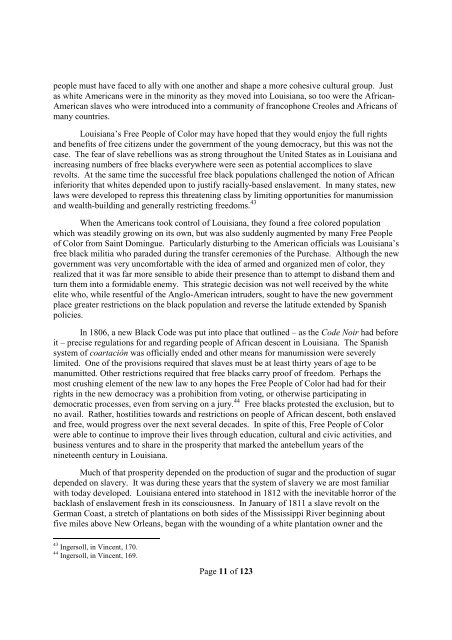The African American Experience in Louisiana
The_African_American_Experience_in_Louisiana
The_African_American_Experience_in_Louisiana
- No tags were found...
You also want an ePaper? Increase the reach of your titles
YUMPU automatically turns print PDFs into web optimized ePapers that Google loves.
people must have faced to ally with one another and shape a more cohesive cultural group. Just<br />
as white <strong>American</strong>s were <strong>in</strong> the m<strong>in</strong>ority as they moved <strong>in</strong>to <strong>Louisiana</strong>, so too were the <strong>African</strong>-<br />
<strong>American</strong> slaves who were <strong>in</strong>troduced <strong>in</strong>to a community of francophone Creoles and <strong>African</strong>s of<br />
many countries.<br />
<strong>Louisiana</strong>’s Free People of Color may have hoped that they would enjoy the full rights<br />
and benefits of free citizens under the government of the young democracy, but this was not the<br />
case. <strong>The</strong> fear of slave rebellions was as strong throughout the United States as <strong>in</strong> <strong>Louisiana</strong> and<br />
<strong>in</strong>creas<strong>in</strong>g numbers of free blacks everywhere were seen as potential accomplices to slave<br />
revolts. At the same time the successful free black populations challenged the notion of <strong>African</strong><br />
<strong>in</strong>feriority that whites depended upon to justify racially-based enslavement. In many states, new<br />
laws were developed to repress this threaten<strong>in</strong>g class by limit<strong>in</strong>g opportunities for manumission<br />
and wealth-build<strong>in</strong>g and generally restrict<strong>in</strong>g freedoms. 43<br />
When the <strong>American</strong>s took control of <strong>Louisiana</strong>, they found a free colored population<br />
which was steadily grow<strong>in</strong>g on its own, but was also suddenly augmented by many Free People<br />
of Color from Sa<strong>in</strong>t Dom<strong>in</strong>gue. Particularly disturb<strong>in</strong>g to the <strong>American</strong> officials was <strong>Louisiana</strong>’s<br />
free black militia who paraded dur<strong>in</strong>g the transfer ceremonies of the Purchase. Although the new<br />
government was very uncomfortable with the idea of armed and organized men of color, they<br />
realized that it was far more sensible to abide their presence than to attempt to disband them and<br />
turn them <strong>in</strong>to a formidable enemy. This strategic decision was not well received by the white<br />
elite who, while resentful of the Anglo-<strong>American</strong> <strong>in</strong>truders, sought to have the new government<br />
place greater restrictions on the black population and reverse the latitude extended by Spanish<br />
policies.<br />
In 1806, a new Black Code was put <strong>in</strong>to place that outl<strong>in</strong>ed – as the Code Noir had before<br />
it – precise regulations for and regard<strong>in</strong>g people of <strong>African</strong> descent <strong>in</strong> <strong>Louisiana</strong>. <strong>The</strong> Spanish<br />
system of coartación was officially ended and other means for manumission were severely<br />
limited. One of the provisions required that slaves must be at least thirty years of age to be<br />
manumitted. Other restrictions required that free blacks carry proof of freedom. Perhaps the<br />
most crush<strong>in</strong>g element of the new law to any hopes the Free People of Color had had for their<br />
rights <strong>in</strong> the new democracy was a prohibition from vot<strong>in</strong>g, or otherwise participat<strong>in</strong>g <strong>in</strong><br />
democratic processes, even from serv<strong>in</strong>g on a jury. 44 Free blacks protested the exclusion, but to<br />
no avail. Rather, hostilities towards and restrictions on people of <strong>African</strong> descent, both enslaved<br />
and free, would progress over the next several decades. In spite of this, Free People of Color<br />
were able to cont<strong>in</strong>ue to improve their lives through education, cultural and civic activities, and<br />
bus<strong>in</strong>ess ventures and to share <strong>in</strong> the prosperity that marked the antebellum years of the<br />
n<strong>in</strong>eteenth century <strong>in</strong> <strong>Louisiana</strong>.<br />
Much of that prosperity depended on the production of sugar and the production of sugar<br />
depended on slavery. It was dur<strong>in</strong>g these years that the system of slavery we are most familiar<br />
with today developed. <strong>Louisiana</strong> entered <strong>in</strong>to statehood <strong>in</strong> 1812 with the <strong>in</strong>evitable horror of the<br />
backlash of enslavement fresh <strong>in</strong> its consciousness. In January of 1811 a slave revolt on the<br />
German Coast, a stretch of plantations on both sides of the Mississippi River beg<strong>in</strong>n<strong>in</strong>g about<br />
five miles above New Orleans, began with the wound<strong>in</strong>g of a white plantation owner and the<br />
43 Ingersoll, <strong>in</strong> V<strong>in</strong>cent, 170.<br />
44 Ingersoll, <strong>in</strong> V<strong>in</strong>cent, 169.<br />
Page 11 of 123


